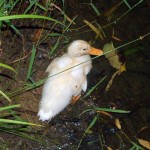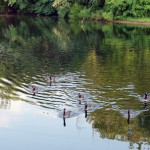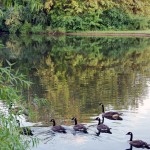Bullfrog Pond located in Broadlands is a hidden quite spot for residents in the area. It is also a home for many wildlife.
View Bullfrog Pond in a larger map
 The Bullfrog is the largest frog in North America. The females grow larger than the males, up to eight inches. Bullfrogs vary in color, from dark olive to pale green above, and from white to cream underneath. They often have dark gray mottling (splotches) on their back legs.
The Bullfrog is the largest frog in North America. The females grow larger than the males, up to eight inches. Bullfrogs vary in color, from dark olive to pale green above, and from white to cream underneath. They often have dark gray mottling (splotches) on their back legs.
Bullfrogs have large eardrums behind the eye, and this is how to tell the male from the females. Males have larger eardrums, which will be bigger than the eye. Females have smaller eardrums, which will be the same size, or smaller, than the eye.
You can tell a Bullfrog from other frogs, like the Green Frog or Pig Frog, by its lack of dorsolateral ridges. These are the two long lines down the back of most frogs.
Bullfrogs are solitary (live alone) animals, and are very territorial. They rarely meet, except to fight over territory or mate. Bullfrogs mate in the Spring.
Bullfrogs lay up to 20,000 eggs in huge sheets, attached to plants under the water. They taste bad to most predators, which gives them some protection.
Eggs hatch into tadpoles, which grow to four to six inches before turning into frogs.
Relationship to Humans: Bullfrogs help humans by eating large amounts of pesky insects, such as mosquitos. Many people eat frog legs, which are almost always from Bullfrogs. Bullfrogs are frequently used for medical research, because their body systems are similar to higher animals. Bullfrogs are currently dissected in many high school biology classes so students can learn animal anatomy.




